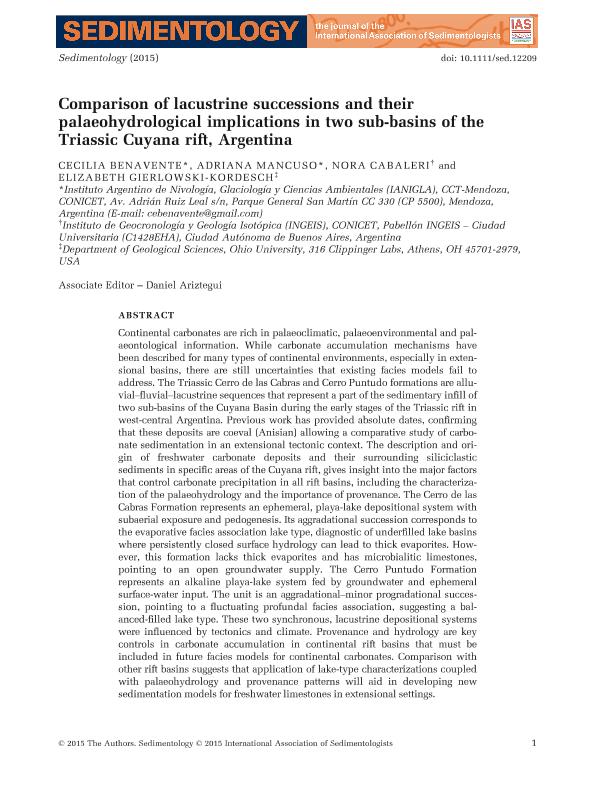Mostrar el registro sencillo del ítem
dc.contributor.author
Benavente, Cecilia Andrea

dc.contributor.author
Mancuso, Adriana Cecilia

dc.contributor.author
Cabaleri, Nora Graciela

dc.contributor.author
Gierlowski Kordesch, Elizabeth
dc.date.available
2017-06-16T19:31:46Z
dc.date.issued
2015-12
dc.identifier.citation
Benavente, Cecilia Andrea; Mancuso, Adriana Cecilia; Cabaleri, Nora Graciela; Gierlowski Kordesch, Elizabeth; Comparison of lacustrine successions and their palaeohydrological implications in two sub-basins of the Triassic Cuyana rift, Argentina; Wiley Blackwell Publishing, Inc; Sedimentology; 62; 7; 12-2015; 1771-1813
dc.identifier.issn
0037-0746
dc.identifier.uri
http://hdl.handle.net/11336/18343
dc.description.abstract
Continental carbonates are rich in palaeoclimatic, palaeoenvironmental and palaeontological information. While carbonate accumulation mechanisms have been described for many types of continental environments, especially in extensional basins, there are still uncertainties that existing facies models fail to address. The Triassic Cerro de las Cabras and Cerro Puntudo formations are alluvial–fluvial–lacustrine sequences that represent a part of the sedimentary infill of two sub-basins of the Cuyana Basin during the early stages of the Triassic rift in west-central Argentina. Previous work has provided absolute dates, confirming that these deposits are coeval (Anisian) allowing a comparative study of carbonate sedimentation in an extensional tectonic context. The description and origin of freshwater carbonate deposits and their surrounding siliciclastic sediments in specific areas of the Cuyana rift, gives insight into the major factors that control carbonate precipitation in all rift basins, including the characterization of the palaeohydrology and the importance of provenance. The Cerro de las Cabras Formation represents an ephemeral, playa-lake depositional system with subaerial exposure and pedogenesis. Its aggradational succession corresponds to the evaporative facies association lake type, diagnostic of underfilled lake basins where persistently closed surface hydrology can lead to thick evaporites. However, this formation lacks thick evaporites and has microbialitic limestones, pointing to an open groundwater supply. The Cerro Puntudo Formation represents an alkaline playa-lake system fed by groundwater and ephemeral surface-water input. The unit is an aggradational–minor progradational succession, pointing to a fluctuating profundal facies association, suggesting a balanced-filled lake type. These two synchronous, lacustrine depositional systems were influenced by tectonics and climate. Provenance and hydrology are key controls in carbonate accumulation in continental rift basins that must be included in future facies models for continental carbonates. Comparison with other rift basins suggests that application of lake-type characterizations coupled with palaeohydrology and provenance patterns will aid in developing new sedimentation models for freshwater limestones in extensional settings.
dc.format
application/pdf
dc.language.iso
eng
dc.publisher
Wiley Blackwell Publishing, Inc

dc.rights
info:eu-repo/semantics/openAccess
dc.rights.uri
https://creativecommons.org/licenses/by-nc-sa/2.5/ar/
dc.subject
CONTINENTAL CARBONATES
dc.subject
LIMNOGEOLOGY
dc.subject
MICROBIALITES
dc.subject
PALAEONTOLOGY
dc.subject
SEDIMENTOLOGY
dc.subject
TECTONICS
dc.subject.classification
Geología

dc.subject.classification
Ciencias de la Tierra y relacionadas con el Medio Ambiente

dc.subject.classification
CIENCIAS NATURALES Y EXACTAS

dc.title
Comparison of lacustrine successions and their palaeohydrological implications in two sub-basins of the Triassic Cuyana rift, Argentina
dc.type
info:eu-repo/semantics/article
dc.type
info:ar-repo/semantics/artículo
dc.type
info:eu-repo/semantics/publishedVersion
dc.date.updated
2017-06-16T15:21:14Z
dc.journal.volume
62
dc.journal.number
7
dc.journal.pagination
1771-1813
dc.journal.pais
Reino Unido

dc.journal.ciudad
Londres
dc.description.fil
Fil: Benavente, Cecilia Andrea. Consejo Nacional de Investigaciones Científicas y Técnicas. Centro Científico Tecnológico Conicet - Mendoza. Instituto Argentino de Nivología, Glaciología y Ciencias Ambientales. Provincia de Mendoza. Instituto Argentino de Nivología, Glaciología y Ciencias Ambientales. Universidad Nacional de Cuyo. Instituto Argentino de Nivología, Glaciología y Ciencias Ambientales; Argentina
dc.description.fil
Fil: Mancuso, Adriana Cecilia. Consejo Nacional de Investigaciones Científicas y Técnicas. Centro Científico Tecnológico Conicet - Mendoza. Instituto Argentino de Nivología, Glaciología y Ciencias Ambientales. Provincia de Mendoza. Instituto Argentino de Nivología, Glaciología y Ciencias Ambientales. Universidad Nacional de Cuyo. Instituto Argentino de Nivología, Glaciología y Ciencias Ambientales; Argentina
dc.description.fil
Fil: Cabaleri, Nora Graciela. Consejo Nacional de Investigaciones Científicas y Técnicas. Oficina de Coordinación Administrativa Ciudad Universitaria. Instituto de Geocronología y Geología Isotopica. Universidad de Buenos Aires. Facultad de Ciencias Exactas y Naturales. Instituto de Geocronología y Geología Isotopica; Argentina
dc.description.fil
Fil: Gierlowski Kordesch, Elizabeth. Ohio University; Estados Unidos
dc.journal.title
Sedimentology

dc.relation.alternativeid
info:eu-repo/semantics/altIdentifier/doi/http://dx.doi.org/10.1111/sed.12209
dc.relation.alternativeid
info:eu-repo/semantics/altIdentifier/url/http://onlinelibrary.wiley.com/doi/10.1111/sed.12209/abstract
Archivos asociados
